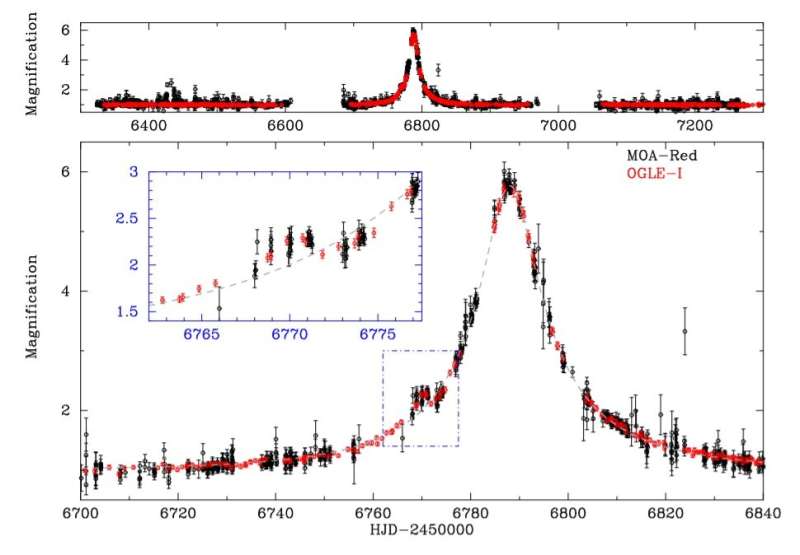Light curve of OGLE-2014-BLG-0319 from the OGLE (red points) and MOA (black points) data. The gray dashed lines in panels represent the best-fit single-lens model. The blue panel shows a zoom-in view corresponding to the area surrounded by a blue chain line. Credit: Miyazaki et al., 2021.
An international team of astronomers reports the detection of a new sub-Jupiter-mass alien world orbiting an M-dwarf star. The newly found exoplanet, designated OGLE-2014-BLG-0319Lb, turns out to be about half as massive as Jupiter. The discovery was detailed in a paper published December 30 on the arXiv pre-print repository.
Based on the gravitational lens effect, the microlensing method is mainly used to detect planetary and stellar-mass objects regardless of the light they emit. This technique is therefore sensitive to the mass of the objects, rather than their luminosity, which allows astronomers to study objects that emit little or no light at all.
The discovery of the microlensing event OGLE-2014-BLG-0319 was announced on March 21, 2014 by the Optical Gravitational Lensing Experiment (OGLE) collaboration. The event was also detected by the Microlensing Observations in Astrophysics (MOA) team and received designation MOA-2014-BLG-171.
Recently, a group of astronomers led by Shota Miyazaki of Osaka University in Japan has analyzed this microlensing event, what revealed the signal indicating the presence of a planetary object. Generally, planetary signals in microlensing events manifest as short-lived anomalous deviations from typical single-lens light curves. Sometimes, these deviations produce a degeneracy problem where several model interpretations are possible for an anomaly.
"In this paper, we analyze a microlensing event OGLE-2014-BLG-0319 that presents three planetary interpretations of different mass ratios," the researchers wrote in the study.
All in all, by analyzing three different models, the team found that the newfound planet has a mass of about 0.49 Jupiter masses and orbits its host some 3.49 AU from it. The parent star is most likely an M dwarf with a mass of some 0.47 solar masses. The system is located near the Galactic bulge, approximately 25,200 light years away from the Earth.
Future follow-up observations with high-angular resolution might be able to shed more light on the properties of the newfound extrasolar world and its host. The researchers noted that several more years might need to pass in order to resolve the lens position and detect the lens flux.
The authors of the paper added that their study underlined the degeneracy problem when it comes to detecting new exoplanets by investigating microlensing events. They concluded that this problem would be more common for short timescale events and thus might have large impacts on the estimation for the frequency of such planets.
"This method would be unlikely successful in shorter timescale events, which are mostly due to low-mass objects, like brown dwarfs or free-floating planets. Therefore, careful treatment is needed for estimating the mass ratio function of the companions around such low-mass hosts which only the microlensing can probe," the astronomers wrote in the study.
More information: OGLE-2014-BLG-0319: A Sub-Jupiter-Mass Planetary Event Encountered Degeneracy with Different Mass Ratios and Lens-Source Relative Proper Motions, arXiv:2112.14997 [astro-ph.EP] arxiv.org/abs/2112.14997
© 2022 Science X Network
























